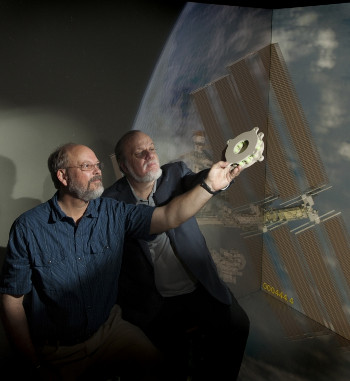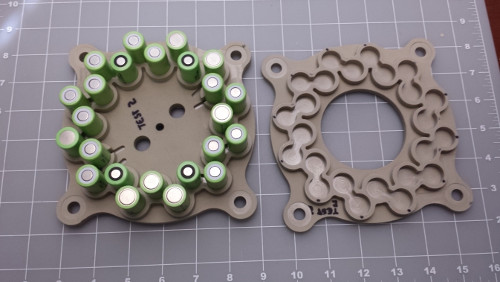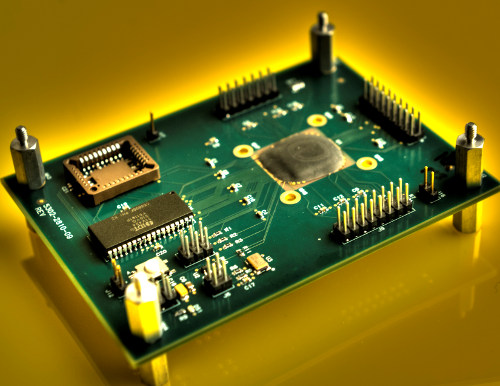 |
| June 10, 2014 | Volume 10 Issue 22 |
Designfax weekly eMagazine
Archives
Partners
Manufacturing Center
Product Spotlight
Modern Applications News
Metalworking Ideas For
Today's Job Shops
Tooling and Production
Strategies for large
metalworking plants
Engineer's Toolbox:
NASA boards the 3D-manufacturing train
By Lori Keesey, NASA's Goddard Space Flight Center, Greenbelt, MD

Goddard technologists Ted Swanson (left) and Matthew Showalter hold a 3D-printed battery-mounting plate developed specifically for a sounding-rocket mission. The component is the first additive-manufactured device Goddard has flown in space. [Image Credit: NASA]
Given NASA's unique needs for highly customized spacecraft and instrument components, additive manufacturing, or "3D printing," offers a compelling alternative to more traditional manufacturing approaches.
"We're not driving the additive manufacturing train, industry is," says Ted Swanson, the assistant chief for technology for the Mechanical Systems Division at NASA's Goddard Space Flight Center in Greenbelt, MD. Swanson is the center's point of contact for additive manufacturing. "But NASA has the ability to get onboard to leverage it for our unique needs."
Led by NASA's Space Technology Mission Directorate, the agency has launched a number of formal programs to prototype new tools for current and future missions using this emerging manufacturing technique. Additive manufacturing involves computer-aided device, or CAD, models and sophisticated printers that literally deposit successive layers of metal, plastic, or some other material until they are complete.
In addition to the U.S. Air Force, DOE, NIST, and NSF, NASA is part of the government team investing in America Makes, formerly known as the National Additive Manufacturing Innovation Institute, a public-private partnership created to transition this exciting technology into mainstream U.S. manufacturing.

This battery case, created with a material called Polyetherketoneketone, is the first 3D-printed component Goddard has flown. Developed under a university-industry partnership, the part was demonstrated during a sounding-rocket mission testing a thermal-control device developed with R&D funding. [Image Credit: NASA]
America Makes is part of the National Manufacturing Initiative, a forward-leaning effort that recognizes our economy requires an advanced, globally competitive manufacturing sector that invents and makes high-value-added products and leading-edge technologies here in the United States.
"NASA's work with additive manufacturing should enable us to be smart buyers and help us save time, expense, and mass," says LaNetra Tate, the advanced-manufacturing principal investigator for the Space Technology Mission Directorate's Game Changing Development Program. "With additive manufacturing, we have an opportunity to push the envelope on how this technology might be used in zero gravity -- how we might ultimately manufacture in space."
As a result of these efforts and others sponsored around the agency, teams of NASA engineers and scientists are investigating how their instruments and missions might benefit from an industry that actually began more than two decades ago, with the introduction of the world's first 3D system.
"This effort really goes beyond one center," says Matt Showalter, who is overseeing Goddard's disparate 3D-printing efforts. Showalter believes Goddard technologists and scientists will benefit most from collaborations with others also investigating the technology's benefits. "It's in the national interest to collaborate with other institutions. This is a powerful tool, and we need to look at how we can implement it. For us, it's a team effort."
Diverse applications
A majority of NASA centers have begun applying the technology to a number of applications pertinent to their areas of expertise.
Goddard, for example, is devoting R&D resources to evaluate the usefulness of 3D printing for a variety of instrument-development efforts. NASA's Langley Research Center, in Hampton, VA, has developed a green-manufacturing process, called the Electron Beam Freeform, or EBF3. It uses an electron-beam gun, a dual-wire feed, and computer controls to remotely manufacture metallic structures for building parts or tools in hours, rather than days or weeks.

NASA engineers are looking for ways to advance a common customizable instrument electronics package called MinE Pack. The device would combine different functions inherent in all instruments -- housekeeping, data processing, power, digitization, control and data handling, and amplification -- all onto a single three-dimensional chip or stack of chips bonded onto a printed wiring electronics board. [Image Credit: NASA]
NASA's Kennedy Space Center in Florida is investigating the use of in-situ regolith, or soil, on extraterrestrial bodies as feedstock for building 3D habitats and other structures. NASA's Ames Research Center in California's Silicon Valley is exploring the application of synthetic biology for the manufacturing of biological materials -- everything from construction materials to foodstuffs -- from small stocks of cells. NASA's Glenn Research Center in Cleveland recently collaborated with Aerojet Rocketdyne of West Palm Beach, FL, to fabricate and successfully test an engine injector for the RL-10 rocket.
Video: And then there are the tools ... astronauts always need tools and parts in space.
In addition, NASA's Marshall Space Flight Center in Huntsville, AL, has used 3D printing to create components for the J-2X and RS-25 rocket engines. The center also is working with Made In Space, a Silicon Valley start-up, to develop a 3D printer that astronauts will use on the International Space Station later this year (scheduled for fall 2014). The idea is that astronauts will create tools and replacement parts they need to operate in space, eliminating the need to transport these items there. The team plans to fly the device on the International Space Station in October 2014.
Published June 2014
Rate this article
View our terms of use and privacy policy
